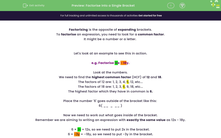Factorising is the opposite of expanding brackets.
To factorise an expression, you need to look for a common factor.
It might be a number or a letter.
Let's look at an example to see this in action.
e.g. Factorise 12x - 18y.
Look at the numbers.
We need to find the highest common factor (HCF) of 12 and 18.
The factors of 12 are: 1, 2, 3, 4, 6, 12, etc...
The factors of 18 are: 1, 2, 3, 6, 9, 18, etc...
The highest factor which they have in common is 6.
Place the number '6' goes outside of the bracket like this:
6( __ _ __ )
Now we need to work out what goes inside of the bracket.
Remember we are aiming to writing an expression with exactly the same value as 12x - 18y.
6 × 2x = 12x, so we need to put 2x in the bracket.
6 × -3y = -18y, so we need to put -3y in the bracket.
So our final answer is:
12x - 18y = 6(2x - 3y)
In this activity, we will factorise expressions by finding highest common factors in terms of numbers.








